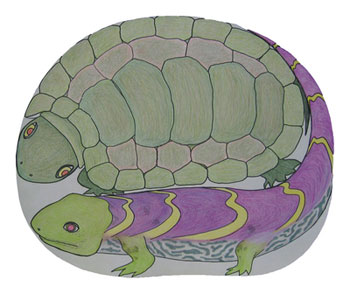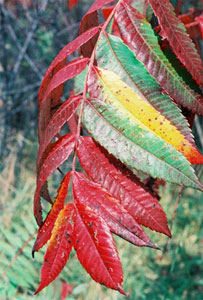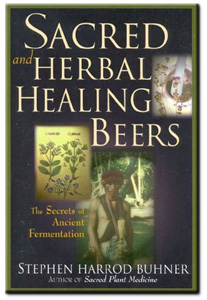Ground Ivy: A Weed by Any Other Name
by Kathy Turcotte
Ground ivy is the first weed I have ever loved. Yes, I did say weed and love in the same sentence.  And no, I have not been out in the sun too long today. Regarded by some as a pesky weed and garden invader, ground ivy is quick to be eradicated upon sight. But wait! Don’t pull it out yet--Praised by Gerard, Culpepper and herbalists down through the centuries, the many virtues of this tiny herb have proved it to be a boon more than a beast, and a panacea more than a pain.
And no, I have not been out in the sun too long today. Regarded by some as a pesky weed and garden invader, ground ivy is quick to be eradicated upon sight. But wait! Don’t pull it out yet--Praised by Gerard, Culpepper and herbalists down through the centuries, the many virtues of this tiny herb have proved it to be a boon more than a beast, and a panacea more than a pain.
If ground ivy were on a “Most Wanted” poster, It would have many aliases: Gill-over-the-Ground, Creeping Charlie or Creeping Jenny, Alehoof, Haymaids, Lizzy-run-up-the-Hedge, Cat’s foot, Robin-run-in-the-Hedge, to name just a few. Catalogued by the 18th century botanist Linnaeus as glechon, Greek for “mint” and hedera, Latin for “ivy,” a century later it was recataloged by English botanist, George Bentham as Nepeta glechoma which translated into “mint mint” or “ivy-like mint.”
The association with the name gill was also claimed by several sources to be derived from French guiller “to ferment beer.” Early Saxton invaders used it to flavor and clarify beer before the conventional use of hops. Gill ale was a popular drink of the time and was believed to impart good health on those who drank it. Naturalized from Europe, ground ivy grows freely throughout the north-eastern, north-central and southern United States.
A member of the Labiatae family, Glechoma hederacea has the classic square stem (often covered in short, bristly backward pointing hairs) of those in the mint family. It is often misidentified as a speedwell or common mallow. A vigorous (and I do mean vigorous) herbaceous perennial with lovely scalloped, kidney shaped leaves of dark green, ground ivy grows by trailing runners, some as long as 36 inches.
Its delicate pixie-like blue to purple-hued funnel shaped flowers bloom from March through late summer. You will find it growing in shade or semi shade, in the woods, in ditches or along roadsides. The fragrance is that of a mint, heady and balsamic. Surely there is nothing disdainful about the cooling scent of mint on a hot summer day.
A Magical Herb
Ground ivy has a strong connection with the powers of magic and divination. Considered a safeguard against sorcery it was worn by milkmaids when first milking cows in the pastures. A magic charm, it was used to prevent the cows from enchantment. In many regions the first milking of the cows was actually done through a wreath of ground ivy.
Other magical uses of ground ivy included promoting sleep, meditation, healing, love, friendship and fidelity. The ritual use of ground ivy was popular and the herb was often woven into crowns and garlands to be worn on Midsummer’s Eve.
“To find out who might be using negative magic against you, place some ground ivy around the base of a yellow candle. Burn the candle on a Tuesday and the person will then become known to you.” Scott Cunningham
A tea of Gill-over-the-Ground may be sipped to help overcome shyness. Strewing leaves of this herb about the floors of your home is said to promote serenity and peaceful dreams.
Ground Ivy Tincture
Gather a few handfuls of ground ivy leaves and flowers on a sunny day. Make sure they have not been sprayed with any insecticide. Gather leaves from your own yard if possible. Do not gather leaves from a roadside where car exhaust would contaminate them. Rinse the leaves of dirt and pat dry.
Remove leaves (and flowers) from stem and lightly pack them in a clean sterilized jar. I find a half pint canning jar with a wide mouth works well. For a smaller amount of tincture you can use a sterilized baby food jar. Fill jar about half full and cover leaves with a good brand of Vodka (at least 80 proof) leaving about one-half to one inch of space between alcohol and lid. Poke a straw or Popsicle stick down the side of the jar to dispel any air that may be trapped in the jar. Place a piece of wax paper cut a little larger than the lid of the jar over the top and screw on lid.
Store jar out of direct light for approximately 4-6 weeks. Inside a warm kitchen cupboard works well. Be sure to shake jar daily and check to be sure that no leaves have risen above the level of the alcohol (you do not want any mold to grow). Poke down any leaves that rise up and add more alcohol if needed. If any of the leaves have turned black, remove them. When your tincture is ready, strain it through a non-bleached coffee filter or piece of cheesecloth into clean amber colored bottles. Be sure to only use tincture bottles with glass droppers.
Usual dosage of tincture is 5-10 drops in a glass of water (or hot tea if you are concerned about the minute amount of alcohol) up to three times daily. If you are pregnant, nursing or on any type of medication, be sure to check with your health care practitioner before use.
An Herb of Many Uses
Ground ivy was highly regarded for its medicinal value. The juice of the plant acted as a diuretic, astringent and diaphoretic making it especially useful for sinus congestion and headaches. A snuff was made from the dried powdered leaves. The expressed juice, used fresh and “snuffed” up the nose prompted relief from colds and migraine headaches.
Gill tea acted as an expectorant and was a popular remedy for coughs and consumption as well as whooping cough, bronchial catarrh and asthma. The high vitamin C content made ground ivy useful in the prevention and treatment of scurvy. Gerard also recommended using it “against the humming noise and ringing sound in the ears, being put into them, and for them that are hard of hearing”
The ability of ground ivy to act as both a stimulant and tonic made gill tea especially useful for those suffering from weak digestive systems and complaints. Acting as a blood purifier, it proved helpful for those suffering from kidney ailments such as gravel or stones.
Gill Tea Spring Tonic - Infuse one ounce of ground ivy with one pint of boiling water sweetened with honey or sugar. When cooled, strain and drink small amounts several times a day.
 As useful externally as it was internally, the juice of ground ivy was used for “black eyes.” Galen engaged the use of the virtues of the flowers, rose ground ivy, celandine and daisies: “stamped, strained and a little sugar and water put thereto, and dropt into the eyes, takes away all manner of inflammation…yea, although the sight were well-nigh gone.”
As useful externally as it was internally, the juice of ground ivy was used for “black eyes.” Galen engaged the use of the virtues of the flowers, rose ground ivy, celandine and daisies: “stamped, strained and a little sugar and water put thereto, and dropt into the eyes, takes away all manner of inflammation…yea, although the sight were well-nigh gone.”
As a lotion or compress, ground ivy was used to cleanse sores and ulcers. When combined with yarrow and chamomile flowers, it made an excellent poultice for abscesses, boils and skin tumors. Culpeper declared it “a singular herb for all inward wounds, ulcerated lungs, or other parts, either by itself, or boiled with like herbs and being drank, in a short time it easeth all griping pains, windy and choleric humours in the stomach, spleen or belly.”
Perhaps the two most interesting uses for ground ivy were its use for painter’s colic (lead poisoning) and sciatica. Gill tea was the tonic of choice for cleansing the blood and tissues of any toxic metals. And, according to Greek physician Dioscorides, “half a dram of the leaves being drunk in foure ounces and a half of faire water for 40-50 days together is a remedy against sciatica or ache in the huckle-bone.”
To Pluck or Not to Pluck
Yes, that one little plant that you are so quick to pluck out had all those uses. And, as I write this, ground ivy is being studied for use in preventing leukemia, bronchitis, hepatitis and various cancers and HIV. Did you know that ground ivy acts as a dense groundcover and keeps the soil from eroding? The lovely blue flowers attract bees, butterflies and on occasion even a hummingbird.
It will also grow where nothing else will and it stays green nearly all year long. I dare you to take your lawnmower and mow over a patch of it this summer, deeply inhaling the tart balsamic scent and not smile. Did I forget to mention that it eases depression? Did I forget to mention that it is FREE?
Okay, so perhaps you don’t need to pull out all of it. Why not find a place where you can let some of it grow freely. Ease yourself into trying a few leaves in your salad, or drinking a cup of Gill tea as a Spring tonic.
If you celebrate Beltane, weave some stems and flowers into your crown. Pick an alias name for it that appeals to you—my personal favorite is Gill-over-the Ground. Repeat it several times until it rolls nicely off your tongue and sounds almost exotic. And, if you must pluck some of it, at least stop and pay homage to the myriad of uses of it throughout time. Ground ivy, a small herb with great determination!
copyright ©2008 Kathy Turcotte
Katherine is a herbalist and student of CCNH. She writes from her home in the Pine Barrens of NJ. A regular contributor to Herb Quarterly magazine, you can visit her and her "White Spirit Deer" at
http://www.enchantedwoodmusings.blogspot.com

Sacred and Herbal Healing Beers:
The Secrets of Ancient Fermentation
 by Stephen Harrod Buhner
by Stephen Harrod Buhner
This is the first comprehensive book ever written on the sacred aspects of indigenous, historical psychotropic and herbal healing beers of the world.
Paperback: 450 pages
Price: $19.95
"Filled with nourishment for the soul, body, and mind, this book is a unique view of the intersection between herbal medicine and fermentation. It will delight anyone interests in herbs, honey, brewing and folktales. Great Book!" -- Susun S. Weed
Order Sacred and Herbal Healing Beers in our Bookshop

Healing
Magic: A Green Witch Guidebook
 by Robin
Rose Bennett
by Robin
Rose Bennett
Follow the path to physical and spiritual health with this how-to
manual filled with ancient lore and wisdom. Using stories, songs,
rituals, recipes, meditations, and trance journeys, it suggests
more than 100 ways to practice the art of magical healing. Find
out how to reconnect with the earth and draw on its energy, interact
with the power of the seven chakras, make use of moon magic and
women's wisdom, prepare herbal infusions and baths, work with the
medicine wheel, and cast spells for love and wealth. No matter what
your beliefs, this guidebook will open your heart and mind to the
joys of everyday life.
Price:
$14.95 plus shipping
Other articles by Robin Rose Bennett
An Herbalists Notebook part 1
An Herbalists Notebook part 2
Order HEALING MAGIC in our Bookshop
“Robin has been practicing Earth Spirit healing, herbalism and Wise Woman ways for twenty years and is an incredibly gifted spiritual teacher, healer and ceremonialist. Robin's powerful teachings come to the reader through a personal writing style that is immediately engaging, sharing practical wisdom through anecdote and example.”
Jen Prosser, Sunstone Herbs









